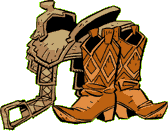HORSEBACK RIDING ACTIVITY CARD
Parts of the Body Worked

Upper & Lower Legs

Heart & Lungs

Abs

Hips & Butt

Lower Back

Whoa, do you know what barrel racing is?
Gear Up
You’ll need a horse, riding gear, and a helmet. Most riding schools will let you borrow these. Pick the horse that’s right for you. If you’re a beginner, go for a horse that is five-years-old or older—they are calmer and give a smoother ride. Your helmet has gotta be ASTM-F 1163 standard and SEI certified, and on right! If your hair is long, tie it up. Wear clothes that aren’t baggy or loose, make sure to button them up, and leave your jewelry at home.
You don’t want to get caught on stuff. Your pants should let you throw your leg over the horse when you’re getting on. If it’s cold out, wear a long-sleeved shirt with a jacket or sweatshirt on top. Waterproof jackets aren’t good because the noise they make could spook (scare) your horse. Riding gloves will stop the reins from slipping out of your hands. Wear hard-toed leather boots or shoes that completely cover your ankles and have heels (not sneakers).
Play it Safe
Approach your horse carefully and from the side—not from behind. You might get kicked! Also, watch your feet, cause it hurts when a horse steps on you. Keep a good grip on the reins at all times so you can control the horse. Lead the horse from its left side with your right hand. Your left hand should hold most of the rope, folded accordion-style. Don’t wrap the rope around your wrist, hand, or body, because if the horse takes off, you don’t want to go with him!
Wear the right gear—check out Gear Up for all the details. Wear a helmet and sturdy boots in the stable and anywhere there are horses—not just when you are riding. Check all your stuff the saddle (leather seat), bridle (part that goes on horse’s head and reins), and cinch (strap around the horse’s belly that holds the saddle on) should be fastened and sturdy.
Until you have some experience in saddle, don’t ride alone. If you are riding in a group, keep at least a horse length away from the others. Know the area where you’re riding. Ride slowly and carefully until you and your horse are familiar with a new route, and where objects or animals could scare the horse. Try to stay away from soft muddy ground, holes, and ditches—horses can trip too!
How to Play
Riding tall in the saddle is an awesome feeling. You’ll have a blast! Start out by riding with a guide at a riding facility—it’s best to take some lessons to learn the basics. To find a place to ride, look in the yellow pages or do an Internet search. There are many different ways to ride horses, and lots of equestrian (horse riding) activities but before you start, you’ll need to know how to:
Mount ‘Em. Stand next to the horse’s left shoulder and face its tail. (Make sure it’s saddled first!) Take the reins in your left hand and grab hold of the bottom of the horse’s mane with your left hand as well. Put your left foot in the left stirrup. Grab the back of the saddle with your right hand. Bounce a little on your right foot and push off, pulling on the saddle and the horse’s mane at the same time to help yourself up. (It doesn’t hurt him!) Swing your right foot over the horse as you let go of the saddle, and put your right foot in the right stirrup.
Ride ‘Em. Squeeze both legs against the horse’s sides and push your hips forward. When the horse starts going, stop squeezing and move your hands forward a bit to loosen the reins. Hold the reins so that you can guide the horse’s head in the direction you want to go—kinda like a steering wheel. But don’t pull back too hard—he’ll start backing up or just stop. Relax and follow the horse’s body.
Games
Play a game of horseshoes! You will need:
- 4 horseshoes—rubber or regular
- 2 stakes or some type of marker that sticks out of the ground, 30 feet apart
- An open area about 6 feet wide and 30 feet long
You need two teams, and each team gets two sets of horseshoes. Decide which team will go first. Have the first player pitch (toss underhand) two horseshoes—one at a time—toward a stake (stake 1) from behind the other stake. (The stakes should be 30 feet, or about 30 steps, away from each other.) Have a player from the other team pitch toward the same stake (stake 1). Now, the next two players—one from each team—pitch toward the other stake (stake 2). Switch back and forth until all players on both teams have pitched. Make sure to stand away from the person pitching so you don’t get whacked with a horseshoe! Scoring: You get 1 point if the shoe is 6 inches or less from the stake, 2 points if it’s touching the stake, and 3 points for circling the stake—a “ringer.” Keep playing until one team has 40 points, or until you’re ready to play something different!
Ology
Horse psychology, that is. You need to use a lot of common sense and caution while riding or handling horses. They’re big, strong, and you can never tell what they’ll do. Treat them with TLC and respect.
Make friends with your horse and help him stay calm. Talk to him softly, stroke him gently, and always let him know where you are. Try to keep one hand on the horse so he knows you’re there. Also, look out for things that might frighten him so you can avoid them.
Fun Facts
Horse lips are like fingers! Horses can’t see the end of their noses, so they use their lips to feel and pick up food (and stay away from stuff that could hurt them.)
When they take down the famous Rockefeller Center Christmas tree in New York City, they give it to the U.S. Equestrian Team headquarters in New Jersey to make into jumps for their Olympics training course.
Horses sleep standing up·without falling over! How do they do it? The muscles and ligaments in their legs “lock up” at bedtime.
Related Links
- Page last reviewed: May 9, 2015
- Page last updated: May 9, 2015
- Content source:



 ShareCompartir
ShareCompartir